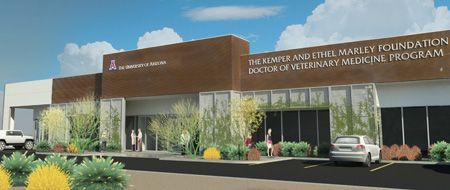University of Arizona aims to open veterinary program in August 2016
AVMA COE will conduct a site visit in January before issuing letter of reasonable assurance for accreditation.
The University of Arizona's College of Agriculture and Life Sciences will host the American Veterinary Medical Association Council on Education (AVMA COE) in January for a site visit to earn a reasonable assurance of accreditation.
The group visited the university in spring 2014 for a consultation and provided a report, Shane C. Burgess, BVSc, PhD, the dean of the College of Agriculture and Life Sciences, tells dvm360. The recommendations were small and manageable, Burgess says.
The COE will issue a decision about the reasonable assurance of accreditation in April, and ASU hopes to open its doctor of veterinary medicine program in August. Job descriptions for new hires and class details are being finalized now, and the hiring process and class scheduling will start in the spring after approval is received.

A mock-up shows the building that will be renovated to house the University of Arizona's Oro Valley Veterinary Clinical Skills Training Facility. The facility will be named after the Kemper and Ethel Marley Foundation because the nonprofit gave the university a $9 million gift to help start the program.
Although a $9 million gift from the Kemper and Ethel Marley Foundation helped start the program, the university has largely used its own resources. “One of the things that's different between us and other programs is that we haven't put a big budget together and hired a bunch of people,” Burgess says. “We've been bootstrapping this program almost entirely using labor from those of us who work in the system already.”
The program would be the state's only public education option for aspiring veterinarians, althought the private Midwestern University recently opened a veterinary college in Glendale, Arizona.
Keeping more students in Arizona, reversing the shortage of veterinarians in rural areas and providing doctors for the animals involved in the region's growing biotech industry are among the factors driving the program's creation, Burgess says. Although rural areas nationwide struggle to attract veterinarians, Burgess says the program will seek to alleviate the problem by selecting students that are more inclined to live in rural areas and graduating students with less debt so they can afford to work in those regions.
Second- to fourth-year students will go to school for 48 weeks a year and have 11 16-week semesters (other programs have eight to nine semesters). The schedule is designed to take four calendar years and contain five academic years but not sacrifice anything in the curriculum.
“We did the math, and frankly it's impossible for students to earn enough money over the summer break to make up for the lost money in terms of extra time and also the opportunity cost of not working that year,” Burgess says.
The program will be founded on three pillars that focus on outcome, not process: commerce, human-animal interdependence and One Health. The commerce aspect involves the entire economic ecosystem, Burgess says, and it explores what makes the economy turn with respect to animals, animal products, regulatory affairs, business law, negotiation and other issues.
Students will have to pass those concepts to learn about the subjects associated with a veterinary education, Burgess says. The program will also address disenchantment and burnout in the profession by ensuring students understand what joining the profession entails and the responsibilities involved.
Oro Valley will be the program's hub, and the final three semesters will be in Douglas, Yuma and Verde Valley for clinical training. There will also be some specialist training through five clinical partner clinics, Burgess says.